Cape Verde Flora
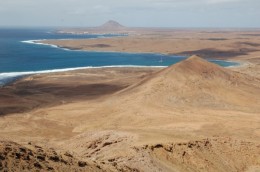
Unless you have never visited the islands and have been entirely fooled by the name, flora will be the last thing that comes to mind when you think of the Cape Verdes – but in fact the place is actually quite interesting to a devoted botanist.
Of the plants which somehow managed to reach the archipelago without man’s intervention (thereby earning themselves the name of indigenous species) there are 80 which have evolved to become genetically different from their ancestors and which are recognised as unique (endemic) species.
See it Here, and Nowhere Else
In past times they may have been abundant but these endemics are all now threatened. Some were grubbed out from the most fertile parts of the islands to make way for the colonists’ chosen crops. Others have been decimated by foraging goats.
One somewhat unimpressive endemic shrub known as lantisco (Periploca laevigata) was found by the settlers to be ideal for the tanning of animal hides. Alas, in the extremity of their need the people also fed it to their livestock and even harvested it for fuel, with the result that it is now rare.
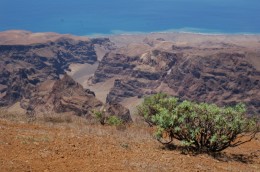
The local spurge, Euphorbia tuckeyana, or tortolho, still grows in various semi-arid places. With its strange, flexible stems oozing white latex the plant is apparently not palatable to goats, but – once again – to people living on the very margins of existence it was still suitable for use as a firewood.
Three endemic echium species known by the common name of lingua de vaca, or cow’s tongue, are also endangered. These near-identical shrubs once covered the low mountain slopes but much of this land was cleared to make way for the colonists’ maize and sugar, and the remaining plants, living in more inaccessible regions, suffered from the attentions of the goat population.
As ever, the echium bushes were also harvested for use as firewood. How short-sighted these people were, I hear someone say. Perhaps… but we might also say, how curious this is; how odd that they should have used shrubs for their fuel instead of wood.
Well, wood is pretty scarce hereabouts. In point of fact, the people also burnt the manure which might otherwise have been spread on their impoverished land to make it more fertile – even 15 years ago they were still doing this – but who are we, who have never known desperate and hopeless need, to accuse them of stupidity?
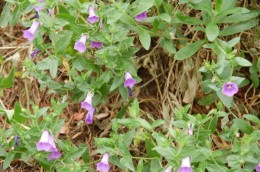
The smaller plants, whilst still being prey to hungry goats, were of absolutely no value as firewood – even the most desperate of peasants would not have gathered wildflowers for his hearth – but there being such little variety in the flora of these arid islands almost every species was deemed to have some sort of purpose. Hidden away in the more humid parts of the high mountains live two pretty little endemic campanulas with delicate bell-shaped flowers. Known as contra-bruxas branco and contra-bruxas azul, these flowers were evidently used, by the more superstitious settlers, to keep witches at bay.
What’s in a Name?
Other plants were considered to be effective in the treatment of more mundane problems such as coughs and colds. One example is espargo (Asparagus squarros), an endemic which also gave its name to the principal settlement on Ilha Sal.
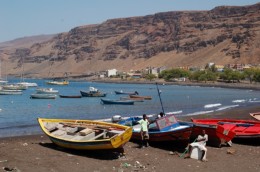
Another plant which has lent its name to no fewer than three villages is a species of tamarisk – or tarrafe, in Portuguese – with the Latin name of Tamarix senegalensis. This scrubby indigenous tree was once common in the mouths of dry ribeiras and even on the beaches, but its use as firewood has meant that it is no longer abundant; not even in Tarrafal de Sao Nicolau, Tarrafal de Santo Antao, or Tarrafal de Santiago.
Some of the endemic plants occur on only one island and in only one location. The macela-de-gordo, for example, is found only in the Monte Gordo region of Sao Nicolau. To judge by its name the plant may always have been restricted to this one area, but the occupation of such a limited range certainly does not aid its survival.
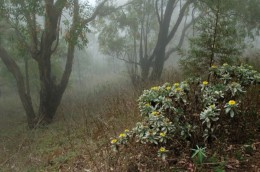
Since it bears a superficial resemblance to St John’s Wort the macela has been adopted by the local people as an emblem of John the Baptist, and on June 21st they hack off branches and deck themselves in the yellow blossoms. Clearly, sacred association is no guarantee of preservation!
The Phoenix and the Dragon
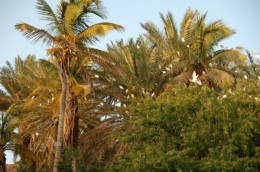
The islands have their own endemic poppy (P.g. theresias) and their own lavender (A. lavandula rotundifolia) which grows on various mountain slopes. They also have an indigenous palm tree – tamareira (Phoenix atlantica) – which grows only on the beaches of the more easterly islands.
The only endemic tree species (occurring here and nowhere else) is a mountain dweller known as marmulano (Sideroxylon marginata). It is also called the iron tree, suggesting that its wood is very hard – and very useful. As a result… yes, you’ve guessed it: the tree is now critically endangered.
The early settlers are known to have made use of an indigenous fig tree (Ficus sycamorus) which was suitable for boat-building and other construction work. Again, its utility had inevitable consequences and nowadays, we are told, the only wild “figueras” are to be found in remote, inaccessible locations. The fig trees which one occasionally sees in the mountain villages have presumably been introduced.
One of the more visible and most threatened indigenous plant species is the dragon tree, Dracena draco. With its big spiky leaves forming a single umbrella-like canopy over its stout little limbs this tree looks positively pre-historic; and having regard for the fact that it lives for more than a thousand years one might say that it is truly deserving of this label.
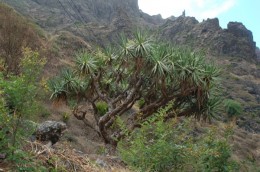
As if its appearance were not enough on its own to inspire ideas of magic and immortality, the dragon tree also spews a red sap. This “dragon’s blood” was used anciently in the Canary Islands as an embalming agent. After the conquest of that archipelago by the Spanish its fame spread to the continent where it became renown as a cure-all; for those who could afford it.
In the Cape Verdes the red sap was used as a painkiller but the bulk of the crop was exported to the mother country. Its use for medicinal purposes made the magic dragon far too popular for its own good. No one knows how many trees there were in the first place but a great many must have been killed by over-tapping. Since it grows very very slowly, taking hundreds of years to mature, the tree could not be farmed sustainably, and it seems unlikely that it will ever recover from mankind’s onslaught. The only hope is for an immensely far-sighted reforestation policy.
The Modern Enemy
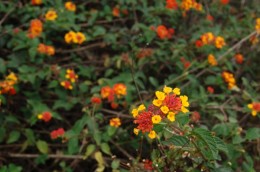
Nowadays the biggest threat to the islands’ flora comes not from goats, nor from people harvesting the plants for fuel or animal fodder or medicine; it comes from exotic (introduced) species which are hardier or faster-growing than the native ones. Two particularly invasive plants are the Australian eucalyptus – which is surely one of the biggest weeds on the planet – and the brightly coloured lantana.
One of the most interesting and least harmful of the exotics is the baobab. For the first forty-odd years of its life this African tree looks a bit like a monkey-puzzle. It has a slender, spiral-patterned trunk and downward sloping branches. Then, all of a sudden, it metamorphoses into one of those forest-goblin trees – the sort that you read about in fairy tales – with a swollen trunk that hides a face, and spiky arms waiting to lean down and snatch at the unwary.
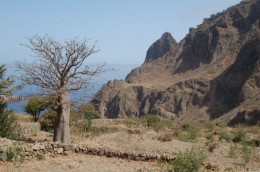
Although it bears fruits – in the form of strange wooden cases which dangle from threads – the baobab never seems to have much in the way of foliage. Legend has it that the tree was accidentally planted upside-down.
By far the most abundant exotics in the Cape Verdes are various species of acacia. As a matter of fact, the islands can actually boast ownership of an indigenous acacia – A. albida, known locally as espinheiro branco – but, as ever, this tree was ruthlessly exploited by the early settlers and there are no stands of virgin acacia forest left. What one does find are acacia plantations, and rows of acacia trees planted on the streets and around the villages.
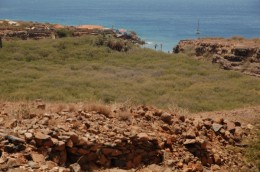
The acacia tree might even be said to be a staple of the islands’ economy for it is the most valuable source of firewood, having – I am told – a far greater biomass than any other species growing here, and it is also an important source of animal fodder. Both the leaves and the bean-pods are edible and one still occasionally sees people gathering them for their pigs.
Reforestation
Their colonial overlords having made no attempt whatsoever to restore the vegetation destroyed over the previous five centuries, by the early years of the 20th century the Cape Verdean people found themselves desperately in want of both firewood and animal fodder (and, for that matter, of food for themselves…). The independence government therefore made reforestation one of their main projects.
For some reason, the tree most used in the reforestation programme was not A. albida but A. americana – also called Prosopis juliflora, and known to the Cape Verdeans as espinheiro-verde.
You can tell the two trees apart because the local species has smaller, more curved pods.
Unfortunately P. juliflora and the other acacias are not very useful trees from the ecological standpoint. Because they are so efficient at mopping up the moisture from the land nothing else can grow in their vicinity.
The more educated, environmentally-minded of the Cape Verdeans tend, nowadays, to deride the wide-spread cultivation of acacias, but according to the Doubleday Foundation, who researched this subject in depth, such an attitude is never to be found amongst the people who still depend on the trees. To quote from their work: “Resistance to drought [and to] repeated cutting and browsing are vital characteristics of all firewood trees that are able to persist here. [Prosopis juliflora‘s] fast growth, ability to ‘burn hot’, and to burn as well when green are very much desired.”
For more information about the Cape Verde islands, take a look at our other recent articles about the archipelago:
- General info:
- Sal
- São Vicente
- Boa Vista
